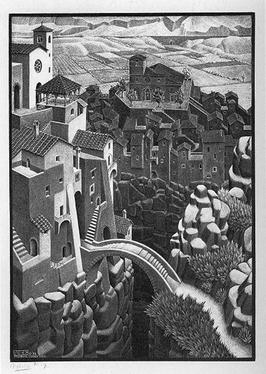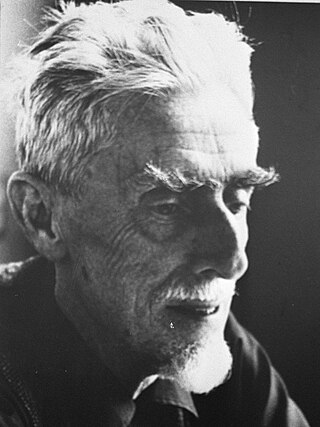
Maurits Cornelis Escher was a Dutch graphic artist who made woodcuts, lithographs, and mezzotints, many of which were inspired by mathematics. Despite wide popular interest, for most of his life Escher was neglected in the art world, even in his native Netherlands. He was 70 before a retrospective exhibition was held. In the late twentieth century, he became more widely appreciated, and in the twenty-first century he has been celebrated in exhibitions around the world.

The Penrose triangle, also known as the Penrose tribar, the impossible tribar, or the impossible triangle, is a triangular impossible object, an optical illusion consisting of an object which can be depicted in a perspective drawing, but cannot exist as a solid object. It was first created by the Swedish artist Oscar Reutersvärd in 1934. Independently from Reutersvärd, the triangle was devised and popularized in the 1950s by psychiatrist Lionel Penrose and his son, prominent Nobel Prize-winning mathematician Sir Roger Penrose, who described it as "impossibility in its purest form". It is featured prominently in the works of artist M. C. Escher, whose earlier depictions of impossible objects partly inspired it.

Castrovalva is a lithograph print by the Dutch artist M. C. Escher, first printed in February 1930. Like many of Escher's early works, it depicts a place that he visited on a tour of Italy.
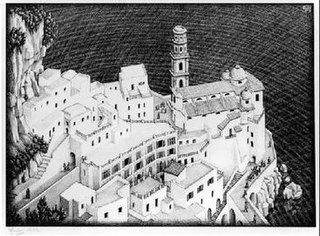
Atrani, Coast of Amalfi is a lithograph print by the Dutch artist M. C. Escher, first printed in August 1931. Atrani is a small town and commune on the Amalfi Coast in the province of Salerno in the Campania region of south-western Italy. Atrani is the second smallest town in Italy and was built right at the edge of the sea. This image of Atrani recurs several times in Escher's work, most notably in his series of Metamorphosis prints: Metamorphosis I, II and III.

Still Life with Spherical Mirror is a lithography print by the Dutch artist M. C. Escher first printed in November 1934. It depicts a setting with rounded bottle and a metal sculpture of a bird with a human face seated atop a newspaper and a book. The background is dark, but in the bottle can be seen the reflection of Escher's studio and Escher himself sketching the scene.

Hand with Reflecting Sphere, also known as Self-Portrait in Spherical Mirror, is a lithograph by Dutch artist M. C. Escher, first printed in January 1935. The piece depicts a hand holding a reflective sphere. In the reflection, most of the room around Escher can be seen, and the hand holding the sphere is revealed to be Escher's.

Still Life and Street is an unusual woodcut print by the Dutch artist M. C. Escher which was first printed in March, 1937. It was his first print of an impossible reality. In this artwork there are two distinctly recognizable realities bound together in a natural yet impossible way. Looked at from the window, the houses make book-rests between which tiny dolls are set up. Looked at from the street, the books stand yards high and a gigantic tobacco jar stands at the crossroads.
Metamorphosis I is a woodcut print by the Dutch artist M. C. Escher which was first printed in May, 1937. This piece measures 19.5 cm × 90.8 cm and is printed on two sheets.

Metamorphosis II is a woodcut print by the Dutch artist M. C. Escher. It was created between November, 1939 and March, 1940. The print measures 19.2 by 389.5 centimetres and was printed from 20 blocks on 3 combined sheets. Metamorphosis II is a long, horizontal piece which depicts animals and other forms gradually transforming into each other.

Reptiles is a lithograph print by the Dutch artist M. C. Escher first printed in March 1943. It touches on the theme found in much of his work of mathematics in art.
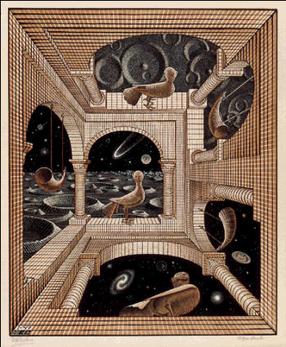
Another World II, also known as Other World II, is a woodcut print by the Dutch artist M. C. Escher first printed in January 1947.

House of Stairs is a lithograph print by the Dutch artist M. C. Escher first printed in November 1951. This print measures 47 cm × 24 cm. It depicts the interior of a tall structure crisscrossed with stairs and doorways.

Puddle is a woodcut print by the Dutch artist M. C. Escher, first printed in February 1952.
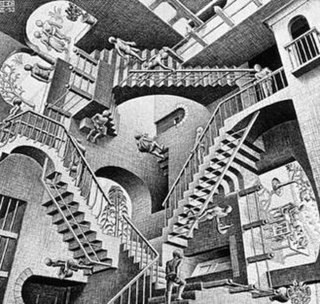
Relativity is a lithograph print by the Dutch artist M. C. Escher, first printed in December 1953. The first version of this work was a woodcut made earlier that same year.

Convex and Concave is a lithograph print by the Dutch artist M. C. Escher, first printed in March 1955.
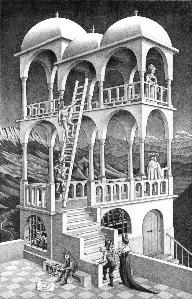
Belvedere is a lithograph print by the Dutch artist M. C. Escher, first printed in May 1958. It shows a plausible-looking belvedere building that is an impossible object, modelled after an impossible cube.

Stars is a wood engraving print created by the Dutch artist M. C. Escher in 1948, depicting two chameleons in a polyhedral cage floating through space.

Goriano Sicoli is a comune and town in the Province of L'Aquila in the Abruzzo region of Italy.

The Glarus thrust is a major thrust fault in the Alps of eastern Switzerland. Along the thrust the Helvetic nappes were thrust more than 100 km to the north over the external Aarmassif and Infrahelvetic complex. The thrust forms the contact between older (Helvetic) Permo-Triassic rock layers of the Verrucano group and younger (external) Jurassic and Cretaceous limestones and Paleogene flysch and molasse.
Day and Night is a woodcut made by the Dutch artist M. C. Escher in 1938.
